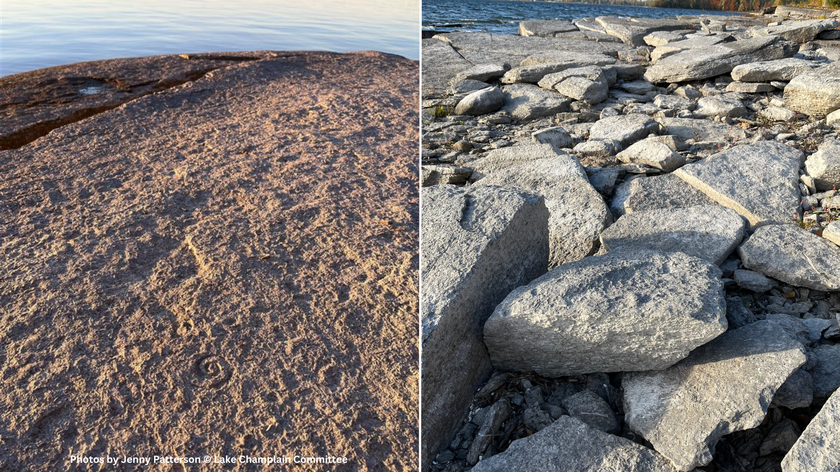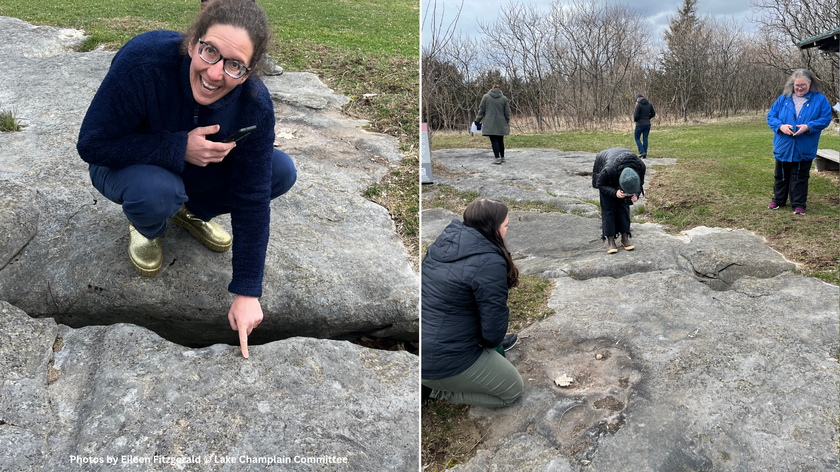Lake Champlain’s Ancient Chazy Fossil Reef
November 2025 Lake Look
As we walk the rocky shorelines of Lake Champlain during this time of low lake levels, we have the chance to view expanses of rock that are usually beneath the water. In certain parts of the lake, those intriguing bumps we may have felt as we waded into the waves in prior years are evidence of the early days of life in what is now called the Chazy Fossil Reef. About 480 million years ago, instead of the chilly, choppy, freshwater lake we’re familiar with, an expansive tropical sea teemed with life. The reef was remarkably diverse considering how new multicellular life was at the time. In fact, the Chazy Reef is the oldest known reef on Earth built by a community of different organisms – the few older reefs are each comprised of a single species.

The Chazy Fossil Reef is visible on Vermont’s Isle La Motte and along portions of the rocky shorelines of northern Lake Champlain in New York, including Valcour and Garden Islands. This reef is the observable portion of the much larger Chazy Formation, which extends from Quebec to Tennessee. The layers that form the reef show the marine environment from the Ordovician Period (about 450 - 480 million years ago), a time when the current-day lands that comprise the Lake Champlain Basin were underwater and in the Southern Hemisphere, near modern-day Zimbabwe.
The Chazy Fossil Reef contains the oldest evidence of the ecological principle of succession. Just as a forest develops from moss and lichen to small herbaceous plants and shrubs, and then to leafy trees with shade-tolerant undergrowth, reefs are built in an ordered ecological sequence. Since reefs consist primarily of animals, the process in those submersed environments is called faunal succession.

You can see this reef progression in the fossil layers of the Chazy Reef. As each species was established, it changed the environment in ways that created habitat for the next species. The foundation began with lots of little Bryozoa: simple invertebrates with tentacle tufts used for filter feeding. Then along came stromatoporoids, once abundant but now extinct relatives of sea sponges which grew upward with distinct horizontal layers. The next horizons of the rock reveal extinct algae, sponges, and the oldest-known reef-building corals, swirling with floral and honeycomb patterns. Trilobites, little segmented aquatic bugs, crawled amidst the living matrix of sponges and coral that formed the reef. Cephalopods, the ancestors of squids and nautiluses, may have been hunting those trilobites—using tentacles to sweep them up and hard beaks to crush their exoskeletons. Prehistoric snails called gastropods inched along with their iconic spiraled shells. A marine ecosystem similar in diversity to today’s coral reefs was booming even before fish evolved.
Evidence of this dynamic and primeval community is entombed in the rocks of the Chazy Fossil Reef. Fisk Quarry and Goodsell Ridge in Isle La Motte are two publicly accessible sites where you can see the fossils for yourself. Fisk Quarry – once mined for its black limestone, which was used in the Vermont Statehouse, the Brooklyn Bridge, and Radio City Music Hall – is now preserved and has examples of the middle reef layers, including the gastropod swirls. Goodsell Ridge hosts trails and interpretive signs that guide visitors through the younger reef layers, with a diverse array of fossil types, including striped trilobites, angled cephalopods, and coiled gastropods, exposed in the bedrock of the mapped out “discovery areas.”

These geologic wonders were protected thanks to a decade of hard work by Linda Fitch and other members of the Isle La Motte Preservation Trust in the wake of a 1995 proposal to reopen the Fisk Quarry for commercial extraction of limestone. The two sites were conserved, and in 2009 earned national recognition along with the rest of the Chazy Fossil Reef when it was designated as a US National Natural Landmark. These ancient reefs were mined for years at Fisk Quarry—hundreds of millions of years of unique history undone in a geological blink. The preservation and ongoing conservation of the Chazy Fossil Reef will keep this natural wonder accessible to the public for generations to come.
Lake Look is a monthly natural history column produced by the Lake Champlain Committee (LCC). Formed in 1963, LCC is a bi-state nonprofit that uses science-based advocacy, education, and collaborative action to protect and restore water quality, safeguard natural habitats, foster stewardship, and ensure recreational access. You can join, renew your membership, make a special donation, or volunteer to further our work.
